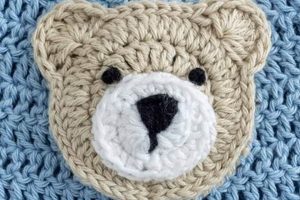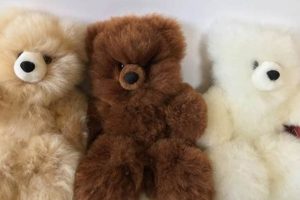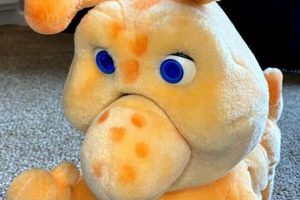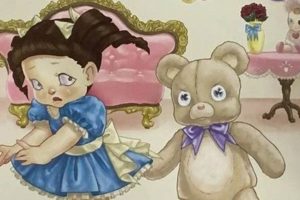Teddy bears manufactured during the 1960s possess distinct characteristics that set them apart. These often include synthetic plush materials, simpler facial features, and vibrant colors reflecting the era’s aesthetic. Examples include bears produced by companies like Ideal, Knickerbocker, and Steiff, each with their own unique designs and materials.
These toys offer a glimpse into the manufacturing processes and popular culture of the mid-20th century. They serve as nostalgic reminders of childhood for many and represent a significant period in the evolution of teddy bear design. Their value lies not only in their potential monetary worth as collectibles, but also in their historical and sentimental significance. Studying them provides insights into the changing trends in toy production and the broader social context of the decade.
This exploration will delve deeper into specific features, prominent manufacturers, and the cultural impact of these vintage playthings. Further discussion will encompass collecting, valuing, and preserving these treasured pieces of childhood history.
Tips on Collecting Vintage Teddy Bears
Acquiring and caring for these nostalgic toys requires careful consideration and attention to detail. The following tips offer guidance for navigating the market and preserving these treasured objects.
Tip 1: Authenticate the Era. Scrutinize manufacturing tags, material composition, and stylistic elements to confirm production within the 1960s. Compare findings with reputable resources and expert opinions.
Tip 2: Assess the Condition. Evaluate the presence of wear, repairs, and overall cleanliness. Original condition enhances value, while repairs, if done professionally, may be acceptable. Consider the impact of these factors on desirability and potential investment.
Tip 3: Research Manufacturers. Familiarize oneself with prominent manufacturers of the era, such as Ideal, Knickerbocker, and Steiff. Understanding their unique styles and materials aids in identification and valuation.
Tip 4: Evaluate Materials. Identify the materials used, such as mohair, synthetic plush, or other fabrics common to the period. This knowledge assists in authentication and informs proper care techniques.
Tip 5: Seek Expert Advice. Consult with reputable antique dealers, collectors’ groups, or teddy bear experts for authentication, valuation, and preservation guidance. Their expertise offers valuable insights for informed decisions.
Tip 6: Proper Storage. Protect vintage plush from direct sunlight, extreme temperatures, and humidity. Use acid-free tissue paper or archival-quality storage containers to prevent deterioration.
By following these guidelines, collectors can confidently navigate the market and ensure the long-term preservation of these historical artifacts. These practices contribute to responsible collecting and the appreciation of these vintage playthings.
The insights provided here offer a starting point for enthusiasts. Further research and engagement with the collecting community will enhance understanding and enjoyment of these nostalgic treasures.
1. Materials (synthetic plush, mohair)
Material composition significantly contributes to the distinct character of 1960s teddy bears. An understanding of prevalent materials provides insights into manufacturing processes, market trends, and the overall aesthetic of the era.
- Synthetic Plush
The increasing use of synthetic plush fabrics, such as acrylic and modacrylic, marked a shift from traditional materials. These synthetics offered advantages in terms of cost-effectiveness, durability, and vibrant color options, reflecting the evolving manufacturing landscape of the decade. Mass-produced bears frequently utilized these materials.
- Mohair
While synthetics gained prominence, mohair, a natural fiber derived from Angora goats, remained a valued material for high-quality teddy bears. Its soft texture and luxurious appearance appealed to a discerning market. Manufacturers like Steiff continued to employ mohair, often for their premium lines.
- Other Fabrics
Beyond plush and mohair, various other fabrics played a role in teddy bear construction. Felt was commonly employed for facial features and paw pads. Cotton or other woven materials sometimes formed inner linings. These supplementary materials contribute to the overall construction and aesthetic of the bears.
- Material Impact on Value
The type of material significantly impacts a vintage teddy bear’s value. Mohair bears, particularly those in good condition, often command higher prices due to the material’s perceived quality and enduring appeal. The rarity of certain synthetic plush variants can also influence their collectibility.
The choice of materials reflects broader trends in the toy industry during the 1960s. The interplay of synthetic and natural fibers underscores the evolving manufacturing landscape and consumer preferences of the period. Understanding these material choices provides valuable context for collectors and enthusiasts seeking to appreciate these vintage treasures.
2. Manufacturers (Ideal, Knickerbocker)
Specific manufacturers played pivotal roles in shaping the teddy bear market during the 1960s. Companies like Ideal Toy Corporation and Knickerbocker Toy Company significantly influenced design trends, material choices, and the overall accessibility of these toys. Understanding their contributions provides crucial context for evaluating and appreciating vintage teddy bears from this era.
Ideal, renowned for its extensive toy production, introduced numerous teddy bear lines throughout the decade. Their bears frequently featured synthetic plush materials, reflecting the industry’s shift toward cost-effective manufacturing. The company’s widespread distribution made their teddy bears accessible to a broad consumer base, solidifying their presence in the popular culture of the time. Examples include the iconic “Kissy Bear” with its distinctive heart-shaped nose and the “Velvet Touch” series known for its soft, synthetic fur.
Knickerbocker also held a prominent market position, specializing in plush toys and character-based merchandise. Their teddy bears often exhibited a classic design aesthetic, sometimes incorporating novel features like musical mechanisms. The company’s focus on quality materials and craftsmanship contributed to their reputation for producing durable and appealing toys. Notable examples include their licensed Disney character teddy bears, which capitalized on the popularity of animated films.
Examining the output of these manufacturers reveals important insights into the evolving landscape of the toy industry. Their choices regarding materials, design, and marketing directly influenced the types of teddy bears available to consumers. This understanding allows collectors and enthusiasts to identify and appreciate the unique attributes associated with each manufacturer. Recognizing these distinctions provides a framework for evaluating the historical significance and potential value of vintage teddy bears.
3. Styles (hard-bodied, bean-filled)
Teddy bear styles prevalent during the 1960s demonstrate a range of construction techniques and design aesthetics. Understanding these variations provides valuable insights into manufacturing processes and evolving consumer preferences. Two notable examples, hard-bodied and bean-filled constructions, offer distinct characteristics that shaped the decade’s teddy bear landscape.
Hard-bodied construction involved the use of a firm internal frame, often composed of molded plastic or other rigid materials. This framework provided structural integrity, allowing the bear to maintain a specific pose or shape. Such designs frequently featured vinyl or plastic faces, adding to their distinctive appearance. These bears catered to a desire for more structured toys and often served decorative purposes. Ideal’s “Thumbelina” doll line frequently incorporated small, hard-bodied teddy bears as accessories, exemplifying this trend.
Bean-filled teddy bears offered a softer, more pliable alternative. Small pellets, typically made of plastic or beans, filled the bear’s body, allowing for flexibility and a tactile, engaging experience. This construction method often resulted in a more casual, “slouchy” posture. Bean-filled bears frequently appeared in children’s playrooms and offered a comforting, malleable texture conducive to cuddling. Knickerbocker produced several bean-filled teddy bears, capitalizing on the growing popularity of this style.
These construction methods represent distinct approaches to teddy bear design and reflect evolving consumer demand. Hard-bodied styles provided structured, visually appealing toys, while bean-filled bears offered a softer, more tactile play experience. Recognizing these stylistic distinctions allows collectors and enthusiasts to better appreciate the diverse range of teddy bears produced during the 1960s and understand the broader context of their design and manufacture.
4. Cultural impact (baby boomers)
The post-World War II baby boom significantly influenced the cultural landscape of the 1960s, including the prevalence and evolution of childhood toys such as teddy bears. This generation, born between 1946 and 1964, represented a substantial consumer market, driving demand for playthings and shaping design trends. Teddy bears became symbolic of this era, embodying comfort, companionship, and the idyllic image of childhood often portrayed in popular media.
The sheer number of children born during the baby boom created unprecedented demand for toys. Mass production techniques, utilizing newly available synthetic materials, allowed manufacturers like Ideal and Knickerbocker to meet this demand. The affordability and availability of these toys further cemented their place within the cultural fabric of the decade. Television programs and advertising campaigns frequently featured teddy bears, reinforcing their presence in children’s lives and contributing to their widespread appeal. For instance, the popular children’s show “Romper Room” often incorporated teddy bears into its programming, showcasing their role as comforting companions for young viewers.
The cultural impact of the baby boom generation extends beyond mere market demand. These toys serve as nostalgic reminders of a specific period in history, evoking memories of childhood and representing the broader social and cultural context of the 1960s. These bears act as tangible artifacts of a transformative era, reflecting evolving family structures, consumerism, and the idealized representation of childhood. Understanding this connection provides valuable context for appreciating the enduring legacy of these toys. It illuminates the intertwining of historical events, demographic shifts, and the cultural significance of seemingly simple objects. Studying vintage teddy bears from this period offers a unique lens through which to examine the broader social and cultural forces shaping the lives of children during this pivotal decade.
5. Collecting value (condition, rarity)
Collecting value represents a significant factor within the realm of vintage teddy bears produced during the 1960s. Condition and rarity directly influence market prices and desirability among collectors. An understanding of these factors is crucial for navigating the complexities of buying, selling, and appraising these nostalgic objects. Condition assessments consider factors such as wear, repairs, and the presence of original features like tags and button eyes. A well-preserved bear with minimal wear and all original components generally commands a higher price. Conversely, significant wear, repairs, or missing parts diminish value. For instance, a pristine Steiff bear from the 1960s with its original button-in-ear tag and chest tag would likely hold significantly more value than a similar bear missing these features or exhibiting significant wear.
Rarity significantly contributes to a teddy bear’s collectibility. Limited production numbers, unique design features, or association with specific historical events or popular culture phenomena enhance desirability. Bears produced in smaller quantities or for a limited time often garner higher prices due to their scarcity. Similarly, bears featuring unusual designs, colors, or materials may be highly sought after by collectors. A teddy bear produced as a promotional item for a specific event or based on a popular television character from the 1960s could be considered rare and, therefore, more valuable. For example, a teddy bear produced in conjunction with the 1964 New York World’s Fair would likely be considered a rare and desirable collectible.
The interplay of condition and rarity shapes the market for vintage teddy bears. A well-preserved, rare example typically commands the highest prices. However, even common bears in excellent condition can hold significant value. Discerning collectors prioritize originality and authenticity, valuing bears with verifiable provenance and minimal alterations. Understanding these factors enables informed decision-making when buying, selling, or appraising vintage teddy bears, fostering responsible collecting practices and preserving these historical artifacts for future generations. These principles underpin the market dynamics for these nostalgic objects, ensuring accurate valuations and promoting ethical collecting practices within a vibrant and evolving collector community.
Frequently Asked Questions
This section addresses common inquiries regarding teddy bears manufactured during the 1960s. The information provided aims to clarify key aspects of collecting, identifying, and preserving these vintage toys.
Question 1: How can one distinguish a 1960s teddy bear from those produced in other decades?
Several key features distinguish these bears. Materials such as synthetic plush and certain types of mohair were prevalent during this era. Facial features, stitching techniques, and overall design aesthetics also reflect the stylistic trends of the 1960s. Manufacturing tags and labels can provide further clues regarding production dates and origins.
Question 2: What are the most prominent manufacturers of teddy bears from the 1960s?
Companies like Ideal Toy Corporation, Knickerbocker Toy Company, and Steiff produced significant numbers of teddy bears during this period. Each manufacturer possessed distinctive stylistic elements and employed specific materials, which can assist in identification.
Question 3: How is the value of a 1960s teddy bear determined?
Several factors influence value, including condition, rarity, manufacturer, and material. Bears in pristine condition with original tags and labels typically command higher prices. Rarity, driven by limited production numbers or unique design features, also contributes significantly to value.
Question 4: What are the best practices for cleaning and preserving a vintage teddy bear?
Gentle surface cleaning with a soft brush or cloth is often sufficient for removing dust and debris. Avoid harsh chemicals or submerging the bear in water. Consult a professional conservator for significant repairs or cleaning of delicate materials. Proper storage in a cool, dry environment away from direct sunlight helps preserve the bear’s condition.
Question 5: Where can one find reputable resources for identifying and valuing vintage teddy bears?
Reputable antique dealers, specialized teddy bear collectors’ groups, and online resources dedicated to vintage toys can offer valuable information for identification and valuation. Auction records and price guides can also provide insights into market trends and estimated values.
Question 6: What are some common misconceptions about 1960s teddy bears?
One common misconception is that all vintage teddy bears are extremely valuable. While some rare examples command high prices, many common varieties possess more modest values. Another misconception is that all bears from this era are made of mohair. The rise of synthetic plush materials led to widespread use of these fabrics in teddy bear production during the 1960s.
Understanding these frequently asked questions offers a foundation for appreciating and preserving these nostalgic treasures. Further research and engagement with the collecting community can provide deeper insights into the world of vintage teddy bears.
Collectors seeking to expand their knowledge can explore dedicated online forums, consult expert appraisers, and attend specialized teddy bear shows and conventions.
Conclusion
Teddy bears manufactured during the 1960s represent a distinct chapter in the history of this iconic toy. This exploration has highlighted key aspects defining their character, from the rise of synthetic plush materials and prominent manufacturers like Ideal and Knickerbocker to the stylistic variations of hard-bodied and bean-filled constructions. The cultural impact of the baby boom generation on the popularity and evolution of these toys underscores their significance as nostalgic artifacts. Furthermore, the interplay of condition and rarity determines their value within a vibrant collecting community.
These vintage playthings offer a tangible link to the past, providing insights into the manufacturing processes, cultural trends, and childhood experiences of a bygone era. Preserving these objects contributes to a deeper understanding of 20th-century material culture and the enduring appeal of a timeless toy. Continued research and dedicated collecting efforts ensure that the stories embodied within these treasured objects remain accessible to future generations.







